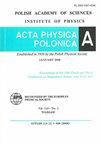参数配置对具有粘性阻尼的网络谐振子自由振动的影响
IF 0.5
4区 物理与天体物理
Q4 PHYSICS, MULTIDISCIPLINARY
引用次数: 0
摘要
异构振荡器网络由描述振荡器状态的动态函数(包含几个参数)和反映振荡器之间连接的拓扑结构组成。揭示系统在不同参数和拓扑结构下的宏观动力学是一个值得探讨的课题,同时也具有很大的挑战性。在本研究中,我们讨论了不同参数构型对经典弹簧振子网络阻尼自由振动的影响。在正则网络上,给出了系统在过阻尼和临界阻尼下的自由振动所满足的解析表达式。进一步讨论了不同参数条件下系统的最快和最慢指数衰减率。结合二次特征值理论,将上述分析从正则网络推广到复杂网络。给出了计算任意参数组态系统特征值谱的一般方法。结合系统的稳定性和指数率的衰减速率,给出了系统特征值的第二大和最小实部的数值模拟结果。最后,通过仿真结果的对比分析,将三个参数(质量、阻尼和度)之间的匹配关系放宽为两个参数(质量和阻尼)之间的匹配关系。本文章由计算机程序翻译,如有差异,请以英文原文为准。
Effect of Parameter Configuration on Free Vibration of Networked Harmonic Oscillators with Viscous Damping
Heterogeneous oscillator networks consist of a dynamical function that describes the state of the oscillator (containing several parameters) and a topology that reflects the connections between the oscillators. Revealing the macroscopic dynamics of systems under different configurations of parameters and topology is a topic worthy of discussion and comes with great challenges. In this study, we discuss the effect of different parameter configurations on the damped free vibration of a classical spring oscillator network. On the regular network, we give the analytical expression satisfied by the free vibration of the system under over-damping and critical damping. Furthermore, we discuss the fastest and slowest exponential rates of decay of the system for different parameter conditions. In conjunction with quadratic eigenvalue theory, we extend the above analysis from regular networks to complex networks. We give a general method for calculating the eigenvalue spectrum of the system for arbitrary parameter configurations. In conjunction with the stability of the system and the rate of decay of the exponential rate, we also give numerical simulation results for the second largest and smallest real parts of the eigenvalues of the system. Finally, through the comparative analysis of the simulation results, we relax the matching relationship between the three parameters (mass, damping, and degree) to the matching between two parameters (mass and damping).
求助全文
通过发布文献求助,成功后即可免费获取论文全文。
去求助
来源期刊

Acta Physica Polonica A
物理-物理:综合
CiteScore
1.50
自引率
0.00%
发文量
141
审稿时长
6 months
期刊介绍:
Contributions which report original research results
and reviews in the fields of General Physics, Atomic and
Molecular Physics, Optics and Quantum Optics, Quantum Information, Biophysics, Condensed Matter, and
Applied Physics are welcomed.
 求助内容:
求助内容: 应助结果提醒方式:
应助结果提醒方式:


